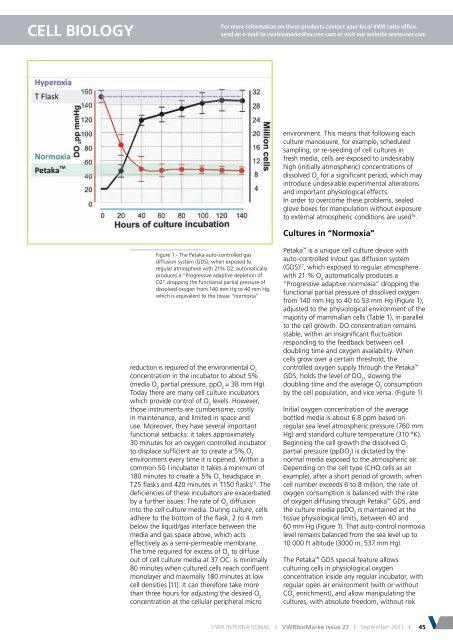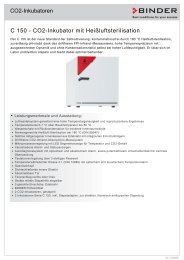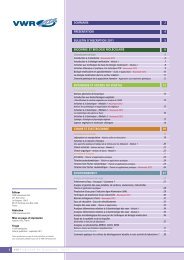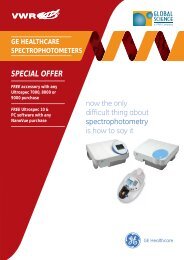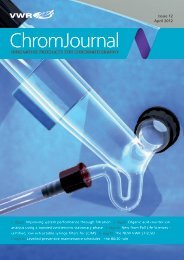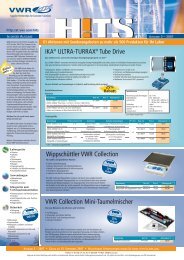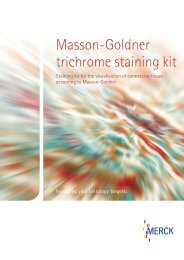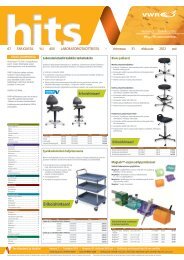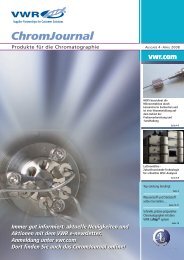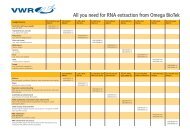CEll bIOlOGy
CEll bIOlOGy
CEll bIOlOGy
You also want an ePaper? Increase the reach of your titles
YUMPU automatically turns print PDFs into web optimized ePapers that Google loves.
Cell biology<br />
For more information on these products contact your local VWR sales office,<br />
send an e-mail to vwrbiomarke@eu.vwr.com or visit our website www.vwr.com<br />
environment. This means that following each<br />
culture manoeuvre, for example, scheduled<br />
sampling, or re-seeding of cell cultures in<br />
fresh media, cells are exposed to undesirably<br />
high (initially atmospheric) concentrations of<br />
dissolved O 2<br />
for a significant period, which may<br />
introduce undesirable experimental alterations<br />
and important physiological effects.<br />
In order to overcome these problems, sealed<br />
glove boxes for manipulation without exposure<br />
to external atmospheric conditions are used 16 .<br />
Cultures in “Normoxia”<br />
Figure 1.- The Petaka auto-controlled gas<br />
diffusion system (GDS), when exposed to<br />
regular atmosphere with 21% O2, automatically<br />
produces a “Progressive adaptive depletion of<br />
O2” dropping the functional partial pressure of<br />
dissolved oxygen from 140 mm Hg to 40 mm Hg,<br />
which is equivalent to the tissue “normoxia”<br />
reduction is required of the environmental O 2<br />
concentration in the incubator to about 5%<br />
(media O 2<br />
partial pressure, ppO 2<br />
= 38 mm Hg).<br />
Today there are many cell culture incubators<br />
which provide control of O 2<br />
levels. However,<br />
those instruments are cumbersome, costly<br />
in maintenance, and limited in space and<br />
use. Moreover, they have several important<br />
functional setbacks: it takes approximately<br />
30 minutes for an oxygen controlled incubator<br />
to displace sufficient air to create a 5% O 2<br />
environment every time it is opened. Within a<br />
common 50 l incubator it takes a minimum of<br />
180 minutes to create a 5% O 2<br />
headspace in<br />
T25 flasks and 420 minutes in T150 flasks 15 . The<br />
deficiencies of these incubators are exacerbated<br />
by a further issues: The rate of O 2<br />
diffusion<br />
into the cell culture media. During culture, cells<br />
adhere to the bottom of the flask, 2 to 4 mm<br />
below the liquid/gas interface between the<br />
media and gas space above, which acts<br />
effectively as a semi-permeable membrane.<br />
The time required for excess of O 2<br />
to diffuse<br />
out of cell culture media at 37 OC. is minimally<br />
80 minutes when cultured cells reach confluent<br />
monolayer and maximally 180 minutes at low<br />
cell densities [11]. It can therefore take more<br />
than three hours for adjusting the desired O 2<br />
concentration at the cellular peripheral micro<br />
Petaka is a unique cell culture device with<br />
auto-controlled in/out gas diffusion system<br />
(GDS) 17 , which exposed to regular atmosphere<br />
with 21 % O 2<br />
automatically produces a<br />
“Progressive adaptive normoxia” dropping the<br />
functional partial pressure of dissolved oxygen<br />
from 140 mm Hg to 40 to 53 mm Hg (Figure 1),<br />
adjusted to the physiological environment of the<br />
majority of mammalian cells (Table 1), in parallel<br />
to the cell growth. DO concentration remains<br />
stable, within an insignificant fluctuation<br />
responding to the feedback between cell<br />
doubling time and oxygen availability. When<br />
cells grow over a certain threshold, the<br />
controlled oxygen supply through the Petaka <br />
GDS, holds the level of DO 2<br />
, slowing the<br />
doubling time and the average O 2<br />
consumption<br />
by the cell population, and vice versa. (Figure 1)<br />
Initial oxygen concentration of the average<br />
bottled media is about 6.8 ppm based on<br />
regular sea level atmospheric pressure (760 mm<br />
Hg) and standard culture temperature (310 ºK).<br />
Beginning the cell growth the dissolved O 2<br />
partial pressure (ppDO 2<br />
) is dictated by the<br />
normal media exposed to the atmospheric air.<br />
Depending on the cell type (CHO cells as an<br />
example), after a short period of growth, when<br />
cell number exceeds 6 to 8 million, the rate of<br />
oxygen consumption is balanced with the rate<br />
of oxygen diffusing through Petaka GDS, and<br />
the culture media ppDO 2<br />
is maintained at the<br />
tissue physiological limits, between 40 and<br />
60 mm Hg (Figure 1). That auto-control normoxia<br />
level remains balanced from the sea level up to<br />
10 000 ft altitude (3000 m, 537 mm Hg).<br />
The Petaka GDS special feature allows<br />
culturing cells in physiological oxygen<br />
concentration inside any regular incubator, with<br />
regular open air environment (with or without<br />
CO 2<br />
enrichment), and allow manipulating the<br />
cultures, with absolute freedom, without risk<br />
VWR International I VWRbioMarke Issue 27 I September 2011 I<br />
45


